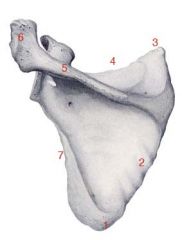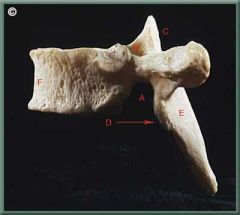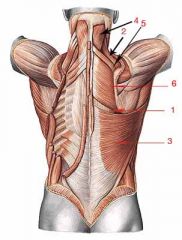![]()
![]()
![]()
Use LEFT and RIGHT arrow keys to navigate between flashcards;
Use UP and DOWN arrow keys to flip the card;
H to show hint;
A reads text to speech;
91 Cards in this Set
- Front
- Back
|
what are the 5 vertebral areas of the back?
|
cervical, lumbar, thoracic, sacral, coccygeal
|
|
|
in which vertebral area are ribs connected to the vertebrae?
|
thoracic
|
|
|
through which hole in the skull does the brain stem exit to become the spinal cord?
|
foramen magnum
|
|
|
to which joints does the vertebral column transfer body weight?
|
sacroiliac joints
|
|
|
what are the two elements of the pectoral girdle?
|
scapulae and clavicles
|
|
|
what are the 2 elements of the axial skeleton?
|
skull, vertebrae
|
|
|
what are the elements of the appendicular skeleton?
|
upper and lower extremities, pectoral girdle, pelvic girdle.
|
|
|
what percentage of the length of vertebral column is composed of intervertebral discs?
|
25%
|
|
|
how many vertebrae are present in the cervical region?
|
7
|
|
|
how many vertebrae are present in the thoracic region?
|
12
|
|
|
how many vertebrae are present in the lumbar region?
|
5
|
|
|
how many vertebrae are present in the sacral region?
|
5
|
|
|
how many vertebrae are present in the coccygeal region?
|
4
|
|
|
which two regions of the veretbral column are fused?
|
sacral and coccygeal
|
|
|
in which 3 regions of the vertebral column does most of the motion occur?
|
cervical, thoracic, lumbar
|
|
|
at which two joints does movement between adjacent vertebrae take place?
|
nuclei pulposus of intervertebral joints and zygapohyseal joints
|
|
|
in which 2 vertebral regions are movements the freest?
|
cervical and lumbar
|
|
|
in which vertebral region is flexion the greatest? extension? lateral flexion?
|
cervical; lumbar; lumbar
|
|
|
which type of movement is most marked in the thoracic region?
|
rotation
|
|
|
which part of the vertebra provides strength in order to support weight of body?
|
vertebral body
|
|
|
which part of the vertebra is composed of the R and L pedicles as well as the laminae?
|
vertebral arch
|
|
|
which processes project superiorly and inferiorly to articulate with the same processes in vertabrae located superiorly and anteriorly? what is the name of the articulations formed?
|
superior and inferior articulate processes; zygapophyseal joints
|
|
|
which processes are locataed at the intersection of laminae and pendicles and are responsible for attachment of ribs in thoracic vertebral region?
|
tranverse processes
|
|
|
which processes project posteriorly from the vertebral arch?
|
spinous processes
|
|
|
which processes serve as levers to which muscles attach and move the vertebrae?
|
transverse processes and spinous process
|
|
|
what is the name for the large hole in the center of the vertebra?
|
vertebral foramen
|
|
|
the superior and inferior vertebral notches are found at the level of which vertebral structure? adjacent inferior and superior notches form what in the vertebral column?
|
pendicles; intervertebral foramina
|
|
|
which joint prevents the vertebrae from slipping anteriorly?
|
zygapophyseal joints
|
|
|
which vertebral area has a particularly large vertebral foramen to accomodate for innervation of upper extremities?
|
cervical
|
|
|
which vertebral area is characterized by transverse foramina? which vessels flow through these foramina?
|
cervical; vertebral arteries
|
|
|
what is another name for the large anterior tubercles of C6? for the spinous process of C7?
|
carotid tubercles; vertebra prominens
|
|
|
the lateral ends of which process in the cervical vertebral region terminate in inferior and superior tubercles?
|
transverse process
|
|
|
what is unique about the spinous processes on vertebrae C3-C5?
|
they are bifid (split)
|
|
|
what is the name for the processes on the vertebral bodies of C3-6 which can form bony spurs?
|
uncinate processes
|
|
|
the superior articular surfaces of which vertebra articulate with the occipital condyles to support the head?
|
atlas (C1)
|
|
|
which vertebra allows for nodding and has no body or spinous process?
|
atlas (C1)
|
|
|
which vertebra is designed to allow the head to shake from side to side?
|
axis (C2)
|
|
|
in which vertebra can one find the dens?
|
axis (C2)
|
|
|
which vertebral region is characterized by long sloping spinous processes?
|
thoracic
|
|
|
what is the reason the lumbar region has large vertebral bodies?
|
to support the weight of the body.
|
|
|
what is the purpose of the mamillary process on the posterior surface of the superior articular process in the lumbar vertebrae?
|
to attach to muscles
|
|
|
why is lumbar puncture easier in the lumbar vertebral region?
|
because the spinous processes are shorter and stubbier, allowing for easier access.
|
|
|
what is the name for the structure formed by the anterior edge of S1? for what purpose is this useful?
|
sacral promontory; important obstetrical landmark
|
|
|
which structure of the sacral vertebral region leads into the sacral canal and provides access to the epidural space?
|
sacral haitus
|
|
|
which structure represents the inferior articular process of S5 and acts as a palpable clinical guide to the sacral haitus?
|
sacral cornua
|
|
|
what are the two regions of the intervertebral discs?
|
annulus fibrosis and nucleus pulposus
|
|
|
what is the name for the ligament which attaches the lamina of two vertebrae? do they limit or encourage flexion?
|
ligamenta flava; limit
|
|
|
which ligaments attach two adjacent spinous processes?
|
interspinous ligaments
|
|
|
which ligament extends from the sacrum to C7 and runs along the spine posterior aspect of the spinous process?
|
supraspinous process
|
|
|
which ligament is responsible for connecting external occipital protuberance to the spinous processes of cervical vertebrae?
|
ligamentum nuchae
|
|
|
which ligament is responsible for attaching the pia mater to the dura mater (it passes through the arachnoid mater) in the spinal column?
|
denticulate ligament
|
|
|
to what are the anterior and posterior longitudinal ligaments anterior and posterior?
|
vertebral body
|
|
|
where does the anterior longitudinal ligament begin? where does it end?
|
occipital bone; anterior surface of sacrum
|
|
|
which is stronger, the anterior or posterior longitudinal ligament?
|
anterior
|
|
|
of the anterior and posterior longitudinal ligaments, which prevents hyperflexion? which prevents hyperextension?
|
posterior; anterior
|
|
|
which layer of intervertebral discs is characterized by lamellae of fibrocartilage?
|
annulus fibrosis;
|
|
|
which layer of intervertebral discs acts as a shock absorber? where are these discs the thickest?
|
nucleus pulposus; in the lumbar region
|
|
|
which type of cartilage can be found between the vertebral body and the intervertebral disc?
|
hyaline
|
|
|
in a herniated disc, which part of the intervertebral disc slips out? what is the most common location for this?
|
nucleus pulposus; L4-5
|
|
|
with which muscle does a synergist muscle work?
|
agonist
|
|
|
what is the role of fixating (stabilizing) synergists?
|
to prevent or control movement at joints proximal to the moving joint thereby providing a fixed or stable base for movement.
|
|
|
what is the role of neutralizing (counteracting) synergists?
|
to prevent unwanted movements of the prime mover
|
|
|
what are the two categories of extrinsic muscles? by what are extrinsic muscles innervated?
|
superficial and intermediate; anterior rami of spinal nerve.
|
|
|
what are the 5 superficial muscles of the back?
|
latissimus dorsi, rhomboid major, rhomboid minor, levator sacpulae, trapezius
|
|
|
what are the two intermediate muscles of the back?
|
serratus posterior superior, serratus posterios inferior
|
|
|
by which nerves are the intrinsic muscles of the back innervated?
|
posterior rami of the spinal nerves
|
|
|
what are the two classifications of intrinsic back muscles?
|
superficial and deep
|
|
|
into what two layers is the superficial intrinsic group of back muscles divided? which muscle composes each?
|
superficial and intermediate; superficial is splenius muscles in neck and upper thoras; intermediate is erector spinae in the trunk (3 layers)
|
|
|
which 3 muscle groups compose the deep intrinsic back muscle group?
|
transversospinalis, segmental, suboccipital groups
|
|
|
the suboccipital triangle connects which 3 bones?
|
occipital bone, axis, atlas.
|
|
|
what is another name for superficial fascia?
|
subcutaneous tissue
|
|
|
1) interior angle
2) medial border 3) superior angle 4) superior border 5) spine 6) acromion process 7) lateral border |

what is the identity of each number (1-7) in this diagram?
|
|
|
what it the name of the meninge directly bordering the spinal cord?
|
pia mater
|
|
|
what is the name of the space between the pia mater and arachnoid mater? what characterizes this space?
|
subarachnoid space; it is filled with CSF
|
|
|
what is the name of outermost meninge? what is located directly outside this later? directly inside?
|
dura mater; epidural space; subdural space
|
|
|
what is the name for the extension of pia mater that extends beyond the spinal cord?
|
internal filum terminale
|
|
|
1) transverse process
2) vertebral body 3) articulate process 4) spinous process 5) vertebral foramen 6) laminae 7) pendicles |

label each part (1-7) of this vertebra.
|
|
|
A) inferior vertebral notch
B) superior vertebral notch C) inferior articular process D) superior articular process E) spinous process F) vertebral body |

label each part of this vertebra (A-F)
|
|
|
the denticulate ligament separates which two structures?
|
dorsal root and ventral root
|
|
|
what is the name for the inferior end of the spinal cord? at which vertebral level does this normally occur?
|
conus medullaris; L2
|
|
|
at which vertebral level is the inferior limit of the dural sac?
|
S2
|
|
|
1) erector spinae
2) levator scapulae 3) latissimus dorsi 4) splenius capitis 5) minor rhomboid 6) major rhomboid |

label each of the muscles in the image
|
|
|
which nerve innervates the trapezius?
|
accessory nerve
|
|
|
where are the 3 facets for rib attachment on thoracic vertebrae?
|
transverse facet on transverse process, superior and posterior demi-facets on vertebral body.
|
|
|
which arteries supply the cervical, thoracic, lumbar, and sacral spinal regions with blood?
|
vertebral arteries, intercostal arteries, lumbar arteries, lateral sacral arteries
|
|
|
what is unique about the veins which drain the vertebrae?
|
they do not have valves and thus allow metastasis of cancer cells via retrograde flow to veins.
|
|
|
in which vertebral regions are the primary curvatures? are these curvatures concave posteriorly or anteriorly? what is the cause of these curvatures?
|
thoracic and sacral; anteriorly; differences in height between the anterior and posterior parts of vertebrae.
|
|
|
in whcih vertebral regions are the secondary curvatures? are these curvatures concave posteriorly or anteriorly? what is the cause of these curvatures?
|
cervical and lumbas; posteriorly; difference in thickness between the anterior and posterior parts of intervertabral discs.
|
|
|
at which vertebral position is the center of gravity?
|
just anterior to S2
|
|
|
what is the name for an abnormal increase in thoracic curvature?
|
kyphosis
|
|
|
what spinal vertebral region is affected by lordosis?
|
lumbar
|

